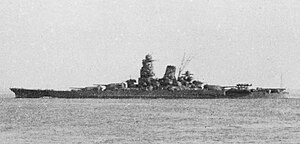 Musashi leaving Brunei in October 1944 for the Battle of Leyte Gulf, where she was sunk by air attack
| |
| History | |
|---|---|
| Name | Musashi |
| Namesake | Province of Musashi |
| Ordered | June 1937 |
| Builder | Mitsubishi Shipyard, Nagasaki |
| Laid down | 29 March 1938 |
| Launched | 1 November 1940 |
| Commissioned | 5 August 1942 |
| Stricken | 31 August 1945[1] |
| Fate | Sunk by American air attack during the Battle of Leyte Gulf, 24 October 1944 |
| General characteristics (as built) | |
| Class and type | Yamato-class battleship |
| Displacement | 63,000 long tons (64,000 t) (standard) |
| Length | 263 m (862 ft 10 in) (o/a) |
| Beam | 38.9 m (127 ft 7 in) (waterline) |
| Draft | 10.86 m (35 ft 8 in) (full load) |
| Installed power | 12 × Kanpon water-tube boilers 150,000 shp (110,000 kW) |
| Propulsion | 4 × propellers; 4 × steam turbines |
| Speed | 27.5 knots (50.9 km/h; 31.6 mph) |
| Range | 7,200 nmi (13,300 km; 8,300 mi) at 16 knots (30 km/h; 18 mph) |
| Complement | 2,500 |
| Sensors and processing systems |
|
| Armament |
|
| Armour |
|
| Aircraft carried | 6–7 × floatplanes |
| Aviation facilities | 2 × catapults |
Musashi (Japanese: 武蔵, named after the former Japanese province[2]) was one of four planned Yamato-class battleships[N 1] built for the Imperial Japanese Navy (IJN), beginning in the late 1930s. The Yamato-class ships were the heaviest and most powerfully armed battleships ever constructed,[4] displacing almost 72,000 long tons (73,000 t) fully loaded and armed with nine 460-millimetre (18.1 in) main guns. Their secondary armament consisted of four 155-millimetre (6.1 in) triple-gun turrets formerly used by the Mogami-class cruisers. They were equipped with six or seven floatplanes to conduct reconnaissance.
Commissioned in mid-1942, Musashi was modified to serve as the flagship of the Combined Fleet, and spent the rest of the year working up. The ship was transferred to Truk, Japan's main wartime naval base in the South Pacific theatre, in early 1943 and sortied several times that year with the fleet in unsuccessful searches for American forces. She was used to transfer forces and equipment between Japan and various occupied islands several times in 1944. Torpedoed in early 1944 by an American submarine, Musashi was forced to return to Japan for repairs, during which the navy greatly augmented her anti-aircraft armament. She was present during the Battle of the Philippine Sea in June, but did not come in contact with American surface forces. During the Battle of Leyte Gulf, Musashi was sunk by an estimated 19 torpedo and 17 bomb hits from American carrier-based aircraft on 24 October 1944. Over half of her crew was rescued. Her wreck was located in March 2015 by a team of researchers employed by Microsoft co-founder Paul Allen.
- ^ Muir, Malcolm (October 1990). "Rearming in a Vacuum: United States Navy Intelligence and the Japanese Capital Ship Threat, 1936–1945". The Journal of Military History. 54 (4): 485. doi:10.2307/1986067. JSTOR 1986067.
- ^ Silverstone, p. 334
- ^ Garzke & Dulin, pp. 74–80, 84
- ^ Cite error: The named reference
j9was invoked but never defined (see the help page).
Cite error: There are <ref group=N> tags on this page, but the references will not show without a {{reflist|group=N}} template (see the help page).